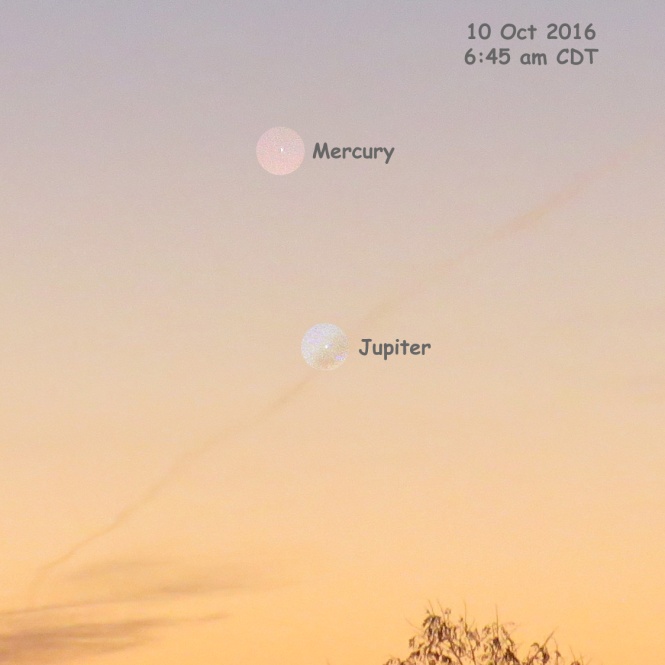Mercury has been visible in the early morning twilight recently. Jupiter is on the opposite side of the Sun from our location. But, Earth is coming around in our orbit catching up to Jupiter. As a result, Jupiter is also a morning twilight object in the same vicinity as Mercury. They were to be very close to each other low in the eastern sky on 11 Oct 2016. Guess what. It was cloudy. But, I did go out on 10 Oct at 6:45 am when it was very clear to capture the view.
The first image is how it looked to my unaided eyes. The second image is zoomed into the center part of the first just above the tallest trees in the vicinity of a faint jet trail.
The evening on 9 Oct was also clear. An email notice told me about a bright reflection off of a communication satellite that was to pass right over my location. The satellites are part of the Iridium system consisting of 72 satellites in polar orbits that provide worldwide coverage for satellite phones. Their 3 antennae shown in the image below are flat and highly reflective of sunlight. The positions and angles of each antenna are known allowing predictions of those reflections across the surface of the Earth.

Iridium LLC
The email notice said the location in the sky was toward 148˚ in the southeast and 50˚elevation. It would last about 10 sec due to the 17,000 mph speed of the satellite.
The sky was dark. I set the camera using a protractor for elevation and Google Earth for direction over my neighbor’s house. I started recording a minute before the due time of 7:52 pm. Success. Here is the video trimmed for time to the actual event.



Thanks for this.
ON a separate note: Only now does the double meaning of “how I see it” sink in
🙂
I watched Iridium satellites a bunch in the past. This is a classic Iridium video! Iridium satellites have pole-to-pole orbits – more or less, I think- so they don’t reflect light for long.
Well done!
Thank you. They are very fleeting. The speed of the reflected spot of light is very fast. I have yet to see one in broad daylight. It would have to be a very transparent sky and in a spot easy to pinpoint. Its like seeing Venus in the daylight. Easier if you know just where to look.
If you are ever passing through this side of the world we have a marvellous set of stars on a clear night. (As long as you are not facing the red flashing windmills.) I think you might like the sky here. c
I know from first hand experience your stars are very nice. I lived in Pontiac from 1969-1972 when I taught in the high school. There were no turbines up in the sky then. But, I did have some bright lights from the prison 2 blocks away and a big water tower across the alley. Had to get out of town to see much.
I remember the Iridium project. The company I was with at the time made some of the nickel-hydrogen battery cells for the project. It was one of the biggest satellite jobs ever, and a commercial flop. But, it still exists as the only effective, albeit expensive, means of reliable instant communication in remote areas of the Earth. With its rather clunky large receiver you can call anywhere from the Sahara, Antarctica, or the Gobi desert. Stanley and Livingston would be amazed.
Astronomically speaking, and thanks to your post, Jim, I found this interesting fact on the Iridium’s Wikipedia page:
There were probably no skywatchers to see the collision, I assume.
That collision was probably at very high speed. Lots of bits and pieces flew.
You’ve had some interesting jobs, Jim. Of the 72 satellites, 66 are operating and 6 are stand by.
I looked up your link and then to ´Iridium Communications Inc.´. It is amazing that all these satellites exist. I have two questions:
1) Motorola and Kyocera are some of the celular transmitters mentioned in the article. Does that mean that other celulars benefit from other existing satellite constellations such as the Iridium?
2) Don’t they have to work with NASA, or are they independent with their own aerospace technology ?
I don’t know either answer. I will see if I can find more info.
1) There are some other satellite constellations. They aren’t as large as Iridium. They provide services ranging from pagers, vehicle tracking, shipment tracking, and messaging. Most services tend to be smaller scale and more regional. https://en.wikipedia.org/wiki/Iridium_Communications#See_also
2) They don’t have to work with NASA. The Iridium satellites were launched by NASA, China, and Russia. Space X the private company of Elon Musk can launch commercial satellites.
I am not an expert in this field. So take my answers with a grain of salt. 🙂
Thank you Jim, this is fascinating, as is your blog. Okay, now I understand there are commercial satellites. I simply thought NASA had to provide the technology for the satellites to be able to run.
Hi Jim, fantastic capture of the flare. I have only ever seen them by chance. It is actually amazing how many satellites are up there. I remember when I was a youngster (and my eyes were good) a friend and I used to search for them. We were happy if we saw one. Now If I point my camera in the same place for five minutes, it will capture several. I sometimes wonder if that’s a good thing. But, then again, on the drive home I listen to satellite radio, usually Classic Vinyl. I guess those streaks, which seem like an annoyance when I look at Orion, are up there because of me, too. Take care. Bob
As of July 1, 2016, there were over 1400 operational satellites. Over 560 are US.
http://www.ucsusa.org/nuclear-weapons/space-weapons/satellite-database#.WABHrJMrLdQ
How many pieces of orbiting junk and dead ones? There are nearly 20,000 trackable objects. Here is an interesting video to show you.
Incredible video! Thanks for passing it along.
You must’ve heard the news about the latest estimate for the number of galaxies in the universe: 2 trillion.
https://www.theguardian.com/science/2016/oct/13/hubble-telescope-universe-galaxies-astronomy
Yes, I did. They were formed very early and evolved/merged into those we see today according to the study. No telescopes today can see them. Perhaps in the future the Webb Telescope will help.
Ah, that’s different indeed from what I heard on the news.
@ Steve & Jim,
Seems to me that increasing the number of galaxies by an order of magnitude diminishes the “dark matter” problem. I wonder, is it possible that the universe is simply more cluttered than we can detect?
The number of stars and galaxies in the present universe is not changed. Neither is the dark matter. A team of astronomers analyzed the visible galaxies in the Hubble Deep Field images for brightness and redshift. They were able to show that the number of dwarf/small galaxies formed in the early stages of the Big Bang is 10x larger than the ones we currently see. We can’t see those oldest young galaxies. Their mathematics confirmed their presence. The young dwarf galaxies merged and evolved into the currently visible ones.
News stories have been saying wrongly that there are 10x more galaxies in the universe. The researchers showed there WERE 10x as many small building block dwarf galaxies back then than we see today.
Great post & pics. The Iridium sats are being replaced by next gen sats, called NEXT. It will be complete ~mid 2018 via SpaceX. Not sure if they will produce the same ‘flare’ we see today, which is the suns reflection off the L-Band antennas. They fly about a 100 miles above the ISS, and function similar to a cell tower. Picture 66 cell towers covering the earth, aligned in 6 north/south planes, with 11 towers in each plane (not including spares). Each sat can talk to the sat in front, behind, and on either side. They came up with 66 sats to cover the largest part of the earth with their L-Band footprint, the equator. Each sat has a footprint about the size of the US. As they move towards the poles and their orbits get closer, they start turning off spot beams to conserve power and shrink the footprint to only what is needed. Truly remarkable they have lasted this long.
Thank you. I watched the SpaceX launch recently when they deployed a bunch of the new ones. I’m glad to see the successes of the commercial launch companies. Today, I read that SpaceX wants to do a trip around the Moon in 2018. Scott Kelly was one of the first to say “I’ll go”.